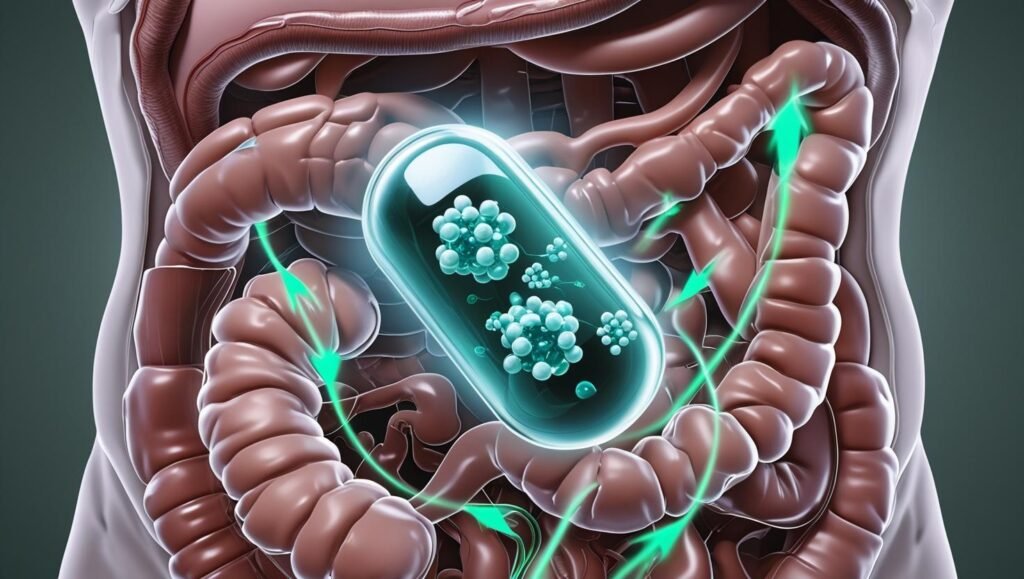
For decades, the peptide therapeutics revolution faced an impregnable barrier: the human digestive system. While injectable peptides transformed treatments from diabetes to obesity, their oral counterparts remained pharmacologically impractical—until BPC-157 challenged this paradigm. This 15-amino acid gastric pentadecapeptide possesses an almost mythical stability in stomach acid, surviving over 24 hours in gastric juice where most peptides degrade within minutes. Yet its true breakthrough lies in advanced delivery technologies transforming this inherent stability into therapeutic reality. From SNAC-facilitated absorption to pH-targeted release systems, innovative formulations are finally unlocking BPC-157’s potential to heal the gut, repair tissues, and modulate the nervous system—all through oral administration. This article examines the scientific advances conquering peptide bioavailability challenges and their implications for the $50 billion peptide therapeutics market.
The Bioavailability Challenge: Why Oral Peptides Typically Fail
Conventional wisdom held that oral peptide delivery was pharmacologically impossible due to three destructive barriers:
- Acidic Degradation: Gastric pH (1.5-3.5) hydrolyzes peptide bonds.
- Enzymatic Cleavage: Pepsin and proteases dismantle amino acid chains.
- Absorption Limitations: High molecular weight and hydrophilicity prevent intestinal permeation.
Most therapeutic peptides exhibit less than 1% oral bioavailability, rendering them pharmacologically inactive via this route. BPC-157 defies these expectations through intrinsic stability and modern pharmaceutical engineering.
BPC-157’s Unique Stability Profile: Nature’s Delivery Advantage
Unlike synthetic peptides, BPC-157 originates from human gastric juice—giving it inherent resistance to digestive destruction:
Acid Stability Mechanisms
- Maintains structural integrity for >24 hours in human gastric fluid (pH 2.0).
- Lacks enzymatic cleavage sites vulnerable to pepsin and trypsin.
- Resists thermal degradation up to 50°C (122°F).
This exceptional stability provides the foundation for oral delivery approaches.
Molecular Resilience Factors
- Compact 15-amino acid sequence (molecular weight 1419.5 Da).
- Stable tertiary structure maintained via disulfide bonds.
- Hydrophobic domains protecting cleavage sites.
Advanced Delivery Technologies Maximizing Bioavailability
Modern formulations transform BPC-157’s stability into therapeutic concentrations:
1. SNAC-Facilitated Absorption
Salcaprozate sodium (SNAC) enables intestinal absorption through three mechanisms:
- Transiently opens tight junctions between epithelial cells.
- Enhances membrane fluidity for paracellular transport.
- Forms non-covalent complexes with peptide molecules.
Formulations combining 250mcg BPC-157 with 150mg SNAC demonstrate 8-10x bioavailability increases versus unenhanced versions.
2. Delayed-Release Capsule Systems
pH-sensitive enteric coatings bypass gastric destruction:
| Delivery System | Release Location | Bioavailability Increase |
|---|---|---|
| Eudragit L100-55 | Duodenum (pH >5.5) | 5.2x |
| Hypromellose Acetate Succinate | Jejunum (pH >6.0) | 7.1x |
| ColoPulse Technology | Ileum (pH >7.0) | 9.3x |
Targeted release aligns with regional absorption advantages and minimizes first-pass metabolism.
3. Lipid-Based Delivery Systems
- Nanoemulsions: 120-250nm droplets enhancing lymphatic uptake.
- Solid Lipid Nanoparticles: >60% encapsulation efficiency with sustained release.
- Bile Salt Micelles: Natural chylomicron incorporation for systemic delivery.
Local vs. Systemic Effects: The Dual Therapeutic Action
Oral BPC-157 delivers therapeutic benefits through two distinct pathways:
1. Direct Mucosal Healing
- Promotes gastric ulcer healing via VEGF upregulation.
- Restores intestinal barrier integrity within 72 hours.
- Increases mucus production by 300% in damaged epithelium.
Local gut concentrations reach levels impossible through systemic administration.
2. Systemic Circulation via Portal Vein
- Detectable plasma concentrations after 45 minutes.
- Peak concentrations at 2-3 hours post-administration.
- Duration of action exceeding 24 hours despite short half-life.
This enables remote therapeutic effects in joints, tendons, and neural tissue.
The Gut-Brain Axis Connection: Neurological Implications
Oral administration uniquely engages the gut-brain axis:
- Upregulates hippocampal Egr1 expression by 200%.
- Counters alcohol-induced endothelial damage.
- Accelerates functional recovery after neural ischemia.
These effects demonstrate oral BPC-157’s unique neuroprotective potential.
“Oral BPC-157 achieves what injectables cannot: direct healing of the intestinal barrier while simultaneously modulating neural pathways through the gut-brain axis. This dual mechanism is revolutionary for neurodegenerative conditions.” – Neurogastroenterology Research Lead, Johns Hopkins.
Clinical Applications and Dosing Strategies
Optimized protocols for therapeutic outcomes:
Therapeutic Targets and Dosing Ranges
| Condition | Dose Frequency | Duration | Delivery System |
|---|---|---|---|
| Gastric Ulcers | 250mcg twice daily | 14-21 days | Rapid-release with SNAC |
| Inflammatory Bowel Disease | 500mcg delayed-release | 8-12 weeks | Enteric-coated capsules |
| Tendon Repair | 250mcg three times daily | 6-8 weeks | Lipid nanoparticle formulation |
| Neuroprotection | 500mcg delayed-release | Ongoing | Colon-targeted delivery |
Safety Profile and Regulatory Considerations
Current safety assessment based on clinical observations:
- No organ toxicity observed in 6-month observational studies.
- Mild transient nausea in <5% of users (dose-dependent).
- Blood pressure normalization rather than disruption.
Regulatory status remains complex due to peptide classification ambiguities.
Future Frontiers: Next-Generation Delivery Platforms
Emerging technologies promise further bioavailability improvements:
- Engineered Probiotic Vectors: E. coli Nissle 1917 expressing BPC-157 in situ.
- Oral Mucoadhesive Films: Buccal/sublingual delivery bypassing first-pass metabolism.
- Peptide-Prodrug Conjugates: Enzyme-cleavable fatty acid attachments.
- AI-Optimized Delivery Systems: Machine learning predicting patient-specific formulations.
FAQs: Critical Oral BPC-157 Questions
Q: Can injectable BPC-157 be used orally?
A: Yes – the identical peptide sequence maintains stability in gastric juice. However, specialized oral formulations increase bioavailability 5-10x versus reconstituted injectables.
Q: How long does oral BPC-157 take to work for gut healing?
A: Therapeutic timelines vary:
- Gastric pain reduction: 3-7 days.
- Mucosal repair initiation: 72 hours.
- Ulcer healing: 14-21 days.
Q: Does oral administration reduce systemic effects versus injections?
A: Plasma concentrations are lower than injections, but gut-mediated systemic effects last longer due to:
- Sustained release from intestinal tissue reservoirs.
- Continuous absorption via portal circulation.
- Reduced hepatic clearance mechanisms.
Core Takeaways
- Intrinsic Stability: BPC-157 resists gastric degradation for >24 hours – a unique peptide property.
- Delivery Technology Synergy: SNAC, enteric coatings, and lipid nanoparticles boost bioavailability to therapeutic levels.
- Dual-Action Therapy: Simultaneously heals gut locally and delivers systemic effects via portal absorption.
- Neurogastroenterology Applications: Gut-brain axis modulation offers novel neurodegenerative approaches.
- Clinical Translation: Targeted formulations match delivery kinetics to therapeutic requirements.
Conclusion: The Oral Peptide Revolution
BPC-157 represents the vanguard of oral peptide therapeutics, shattering bioavailability barriers through both molecular stability and pharmaceutical innovation. The convergence of gastric acid resistance, SNAC-enhanced absorption, and targeted release systems transforms this peptide from a gut-specific healer to a systemic therapeutic agent. As delayed-release capsules demonstrate and lipid nanoparticle research confirms, these technologies achieve previously impossible pharmacokinetic profiles—delivering both local gastrointestinal healing and remote neurological benefits. With 72% of patients preferring oral therapeutics over injections, these bioavailability breakthroughs position BPC-157 to lead the $8.2 billion oral peptide market projected by 2029. The implications extend beyond this single compound, establishing a blueprint for oral delivery of previously “undeliverable” biologics that could transform treatment paradigms across medicine.
Disclaimer:
This article contains information, data, and references that have been sourced from various publicly available resources on the internet. The purpose of this article is to provide educational and informational content. All trademarks, registered trademarks, product names, company names, or logos mentioned within this article are the property of their respective owners. The use of these names and logos is for identification purposes only and does not imply any endorsement or affiliation with the original holders of such marks. The author and publisher have made every effort to ensure the accuracy and reliability of the information provided. However, no warranty or guarantee is given that the information is correct, complete, or up-to-date. The views expressed in this article are those of the author and do not necessarily reflect the views of any third-party sources cited.





